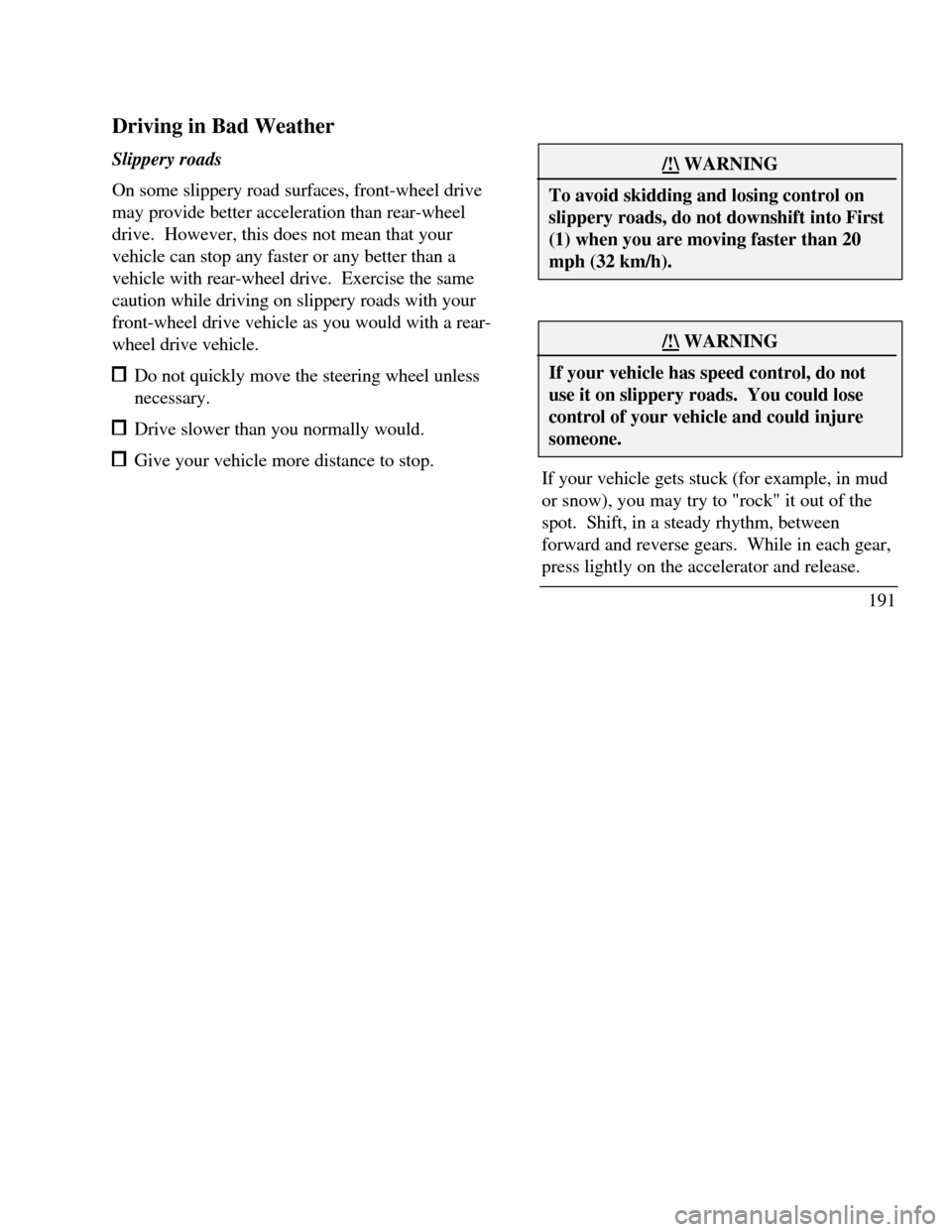Page 194 of 320

Driving in Bad Weather
Slippery roads
On some slippery road surfaces, front-wheel drive
may provide better acceleration than rear-wheel
drive. However, this does not mean that your
vehicle can stop any faster or any better than a
vehicle with rear-wheel drive. Exercise the same
caution while driving on slippery roads with your
front-wheel drive vehicle as you would with a rear-
wheel drive vehicle. Do not quickly move the steering wheel unless
necessary. Drive slower than you normally would. Give your vehicle more distance to stop./!\ WARNINGTo avoid skidding and losing control onslippery roads, do not downshift into First(1) when you are moving faster than 20mph (32 km/h)./!\ WARNINGIf your vehicle has speed control, do notuse it on slippery roads. You could losecontrol of your vehicle and could injuresomeone.If your vehicle gets stuck (for example, in mud
or snow), you may try to "rock" it out of the
spot. Shift, in a steady rhythm, between
forward and reverse gears. While in each gear,
press lightly on the accelerator and release.
191
Page 207 of 320

Changing a Tire
if you get a flat tire while you are driving, do not
apply the brake heavily. Instead, gradually decrease
the speed. Hold the steering wheel firmly and
slowly move to a safe place on the side of the road.
Park on a level spot, turn off the ignition, set the
parking brake, and turn on the hazard flashers.
The Temporary Spare Tire
You may have a high pressure temporary spare tire.
This spare tire is smaller than a regular tire and is
designed for emergency use only. Use it only when
you get a flat tire and replace it as soon as you can.
This spare tire is marked with the words
"TEMPORARY USE ONLY" so that you can easily
identify it.
204/! WARNINGIf you use the temporary spare tirecontinuously or do not follow theseprecautions, the tire could fail, causing you tolose control of the vehicle, possibly injuringyourself or others.When you drive with the temporary spare tire,
DO NOT: exceed 50 mph (80 km/h) under any
circumstances. load your vehicle so that it is heavier than the
maximum vehicle load rating listed on the tire
decal. tow a trailer. try to repair the temporary spare tire or remove it
from its wheel. use the wheel for any other type of vehicle.
Page 239 of 320
Engine coolant reservoir Power steering fluid reservoir Windshield washer fluid reservoir Engine oil filler cap Hood safety release High current fuse box Engine oil
dipstick Air filterEngine compartment service points
237
Page 266 of 320
/!\ WARNINGDo not let the reservoir for the mastercylinder run dry. This may cause the brakesto fail.The brake fluid reservoir
264Power Steering Fluid
Check the level of the power steering fluid at least
twice a year (i.e., every Spring and Fall).
Checking and Adding Power Steering
Fluid
1. Start the engine and let it run until the power
steering fluid reaches normal operating
temperature. The power steering fluid will be at
the right temperature when the engine coolant
temperature gauge in the instrument cluster is
near the center of the NORMAL operating
temperature range.
2. While the engine idles, turn the steering wheel
back and forth several times. Make sure that the
cap assembly is installed at this time.
Page 267 of 320
3.Turn the engine off and check the level on the
power steering reservoir.
4.The fluid level is viewed through the sight
window on the power steering reservoir. If the
power steering fluid is below the middle line,
add fluid in small amounts, continuously
checking the level. Do not overfill.The power steering fluid reservoir
265
Page 268 of 320
Use only MERCONÒ ATF power steering fluid.
If the power steering fluid is low, do not drive your
vehicle for a long period of time before adding fluid.
This can damage the power steering pump.
Fuses
Fuses (conventional and high current) protect your
vehicle's electrical system from overloading. If
electrical parts in your vehicle are not working, the
system may have been overloaded and blown a fuse.
Before you replace or repair any electrical parts,
check the appropriate fuses (conventional and high
current).
266The following charts tell you which fuses protect
each electrical part of your vehicle. If a fuse blows,
all the parts of your vehicle that use that circuit will
not work.
Once you have determined which fuses to check,
follow the procedures under Checking and replacing
fuses in this chapter.
Page 277 of 320
Fuse
LocationMaxi-Fuse
Amp RatingDescription22Not used23Relay
· HI beam headlamps relay2420A
· Fuel pump2520A
· Thermactor pump26Relay
· EATC blower motor relay2730A
· PCM
· STC28Not used29Relay
· Horns relay30Relay
· Powertrain control module
relayChecking and Replacing Fuses
If you need to check a fuse, follow these steps:
1. Find the fuse panel underneath the instrument
panel to the left of the steering column.
Squeeze together the two areas indicated by
the arrows and pull down to remove the
cover.
2. Find the fuse you want to check (fuses are
numbered on the fuse panel) and remove it
with the fuse pulling tool that is provided.
3. Check the fuse to see if it is blown. Look
through the clear side of the fuse to see if the
metal wire inside is separated. If it is, the fuse
should be replaced.
275
Page 289 of 320

3.Drive to accumulate at least four (4) minutes
in the range of 30-45 mph (50-70 km/h). If
stop and go conditions occur, the
accumulative time must be within the 30-45
mph (50-70 km/h) range. No wide open
throttle conditions should be encountered.
4.Cruise and maintain a select speed in the range
of 30-40 mph (48-64 km/h) on a level road
with throttle held very steady for at least one
(1) minute.
5.Decelerate and idle for at least 80 seconds.
6.Accelerate to 55 mph (90 km/h) at ½ throttle.
7.Decelerate at closed throttle for I 0 seconds.
8. Cruise and maintain a select speed in the range
of 40-65 mph (64-105 km/h) on a level road
with throttle held very steady for at least 80
seconds.9. Complete 10 minutes of city driving 25-40 mph
(40-64 kin/h) with at least six (6) stops.
10. OBD II drive cycle has been completed.
Vehicle can be turned off when convenient.
Refill Capacities, Motorcraft Parts,
and Lubricant Specifications
Refill Capacities
ComponentU.S.MetricCooling system
(including heater)14.25 qts.13.5 litersEngine oil
(with filter change)6.0 qts.5.7 litersTransaxle
Auto. overdrive13.7 qts.13.0 litersPower steering2.5 pints1.2 litersFuel tank17.8 gallons67.4 litersPressure cap16 psiI 10 kPa287